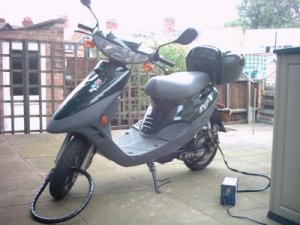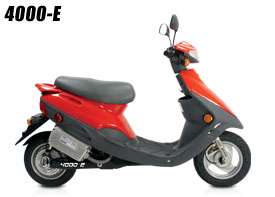A Eulogy & User's Guide to Electric Vespa-style scooters
- by evangelical , Leicester-based Scoot Electric customer and ex-petrol moped owner - Simon Kear. Covers everything from all-weather gear and insurance to real-world performance and running costs - plus countless reasons why you should pull the plug on petrol-power.

Simon's EVT4000e costs next-to-nothing to charge
Background
I am an experienced rider and have had a full motorcycle licence for 20 years. I work partly from home and partly on the campus of the University of Leicester. I have slight mobility problems which make walking distances of 500m or more very tiring.
I decided to make the switch to low-powered two-wheeled transport in 2004. My thinking was that if I found using a moped to be better than a car, I would upgrade to a better bike in the spring. At this stage, I still hadnít decided on an electric or petrol upgrade. As it happens, some Leicester youths saved me the trouble of selling or scrapping the Honda by stealing it from my driveway one week before the new MoT was due.
Having used the Honda for six months, I was convinced this was the way to go. I could go door-to-door, whizz past stationary traffic and always be at the head of the queue at the traffic lights. Apart from the weather, I had an advantage over car users in every respect.
So what was it to be, petrol or electric? I already knew all I needed to know about petrol mopeds (and that, at 40 years old, I had no desire whatsoever to tinker with one). With some trepidation, I approached the excellent team at ScootElectric (www.scootelectric.co.uk), the UKís foremost importer, supplier and maintainer of electric mopeds/scooters. The staff were extremely knowledgeable and bent over backwards to answer my questions. Despite some obvious reservations (eg, would I run out of charge miles from home? Would other road users hear me? Would the moped break down frequently?), I purchased an EVT 4000e in April 2005.

The award-winning direct drive EVT 4000e
So how do I feel about my decision some seven months on? Well, if you donít fancy reading the rest of this review, take the following as the gospel truth: if you buy an electric moped like my EVT 4000e, it will be the best money you spend. Ever. Quite simply, I have been blown away by it. Itís the best-kept secret on the roads.
Technical Stuff
OK, so perhaps we should look at some more concrete facts rather than relying on my word.
Because the EVT needs to be recharged everyday, I had an electrician place an outdoor plug socket on an outside wall. So when I park up at home, I place the EVT on its stand, lock the front wheel with a heavy-duty cable, plug in the charger and switch it on. Thatís it.
The EVT takes 4-5 hours to charge from empty. However, the reality is somewhat different. For a start, itís very rare that the batteries will be completely empty. This means that you can recharge for an hour or so and find yourself back up to full charge. Also, most of the charging happens in the first couple of hours, so you should be able to get back on very soon.
As an example, I might do 25 miles on my EVT during the course of the day (the EVT has a range on a full charge of 30-35 miles) but find that I need to do another 15 miles in an hour or so. Now the batteries will be fairly drained after 25 miles, so I recharge for an hour-and-a-half before heading off. Based on my experiences thus far, I know that the EVT will get to its destination with charge to spare. And, of course, at the other end, I plug it in again, and so on.
With regard to Ďfuelí, the trick to using an electric moped is not to think of it as a moped at all. Think of it in the same terms as a Dustbuster, rechargeable torch or even a mobile phone. It just happens to look and ride like a moped. Miles-per-gallon and other carbon-fuel based measurements are somewhat irrelevant.
The EVTís batteries do not have Ďmemoryí, so, once youíve correctly followed the breaking-in instructions, a recharge session can be five hours or half-an-hour; it makes no difference to the life of the batteries (approximately two years). However, if I were not to use the EVT for several months, I would have to make sure that it was fully topped up every two weeks or so.
The EVT uses an external charger (about the size of a pencil box). I think the decision to use an external charger was taken by EVT at the design stage, as there is no advantage to the rider in having this. (Other electric scooters use an on-board charger.) I keep my charger in a waterproof plastic packing case at home. However, if I had a daily journey of 25 miles, I would have to take the charger with me (it fits under the seat) and set it up at the other end. Not a great hassle, I agree, but not a boon, either.
TIP: I got a much greater range once the EVT had been through a few recharge cycles (i.e., after a month or so).
The Ride
Straight off, the EVT is a fantastic ride. It has a heavy centre of gravity (due to the batteries) and sticks to the road like glue. The brakes (disc front and drum rear) are excellent, as is the suspension. The throttle response is actually considerably better than any restricted 50cc mopeds. Itís smooth and quick, and can be boosted by switching on the Power mode button with the right-hand thumb.
For normal riding conditions, I use the EVT in Economy mode. This gives me the maximum range from the batteries. In Economy mode, the EVT cruises along at about 29-30mph, which is more than adequate for a busy high street with many pedestrians.
Power mode allows the EVT to reach speeds of 35mph and is very useful for pulling away at traffic lights. You can ride in Power mode at all times, but it will reduce the range of a full charge to about 15-18 miles. Iíve actually reached 45mph once, but I was coming down a fairly steep slope and, yes, I did have my head buried in the clocks. What fun!
Of course, being electric, the EVT is very quiet, but it isnít silent. This actually is a very good thing. Would anyone want to be completely silent when using our roads, where all of us (cars, motorbikes, bicycles, pedestrians) have to rely on so many audio and visual clues just to survive? The EVT has a very healthy, low-frequency hum. It is clearly audible to pedestrians crossing the road.
TIP: One thing about switching from four wheels to two is the weather. My partner (who has a Helio scooter from ScootElectric) and I both get around this by using Australian Driza-Bone© coats. They are 100% waterproof, are designed for riding (well, mopeds are like horses) and, because we bought slightly larger sizes, fit comfortably over anything else we wear. Better than climbing out of soaking-wet waterproofs.
Maintenance
What maintenance? All I do is check the tyre pressure every few weeks. Thatís it. Everything. Next topic?
Costs
So the EVT is nimble, quiet, smooth to ride and maintenance free. Thatís all great, but where it really shines is in its running costs Ė or rather, lack of. Put it this way, we are all aware of our energy costs and, Iím sure, try to reduce them whenever possible (for example, by installing double-glazing). However, how often does anyone take this into account when recharging a mobile phone, or plugging in a new DVD player or a fridge? Thatís pretty much what Iím talking about. Now, to be fair, it doesnít really cost a great deal to run a petrol moped. However, it costs virtually nothing (in the sense that one generally doesnít worry about the cost of plugging in a new appliance at home). Also, who wants to queue up at a petrol forecourt on a cold February morning when you could be having an extra cup of tea?
And because the EVT is modular in design with very few parts (moving or otherwise), you donít have all that mucky fiddling around which is inevitable with any petrol engine. It was fun when I was 16, maybe, but not now.
I pay about £180 for insurance from Lexham (www.lexhaminsurance.co.uk). Road tax is free because the EVT is an electric vehicle.
And finally...
Thereís one more advantage to the EVT that I havenít mentioned thus far: the environmental impact. The EVT is quiet, emission-free and, according to Greenpeace, has an environmental impact some ten times less than that of a petrol scooter. In other words, a petrol moped is ten times more polluting than an electric moped.
I feel that, as with giving charity, this is an issue of personal conscience (although probably not for much longer). Switching to greener living seems to entail certain increased expenses. For many people, this is beyond the household budget. For others, it is lifestyle choice.
I left this heading until last because I donít feel that the reduced environmental impact is the EVTís greatest selling point. Let me re-word that. For me, it was the greatest selling point but I wouldnít presume to preach to others who I know are more than capable of making their own personal decisions of conscience. However, I hope that this review has shown that the EVTís other selling points (cost, maintenance etc.) are equally valid and, for many people, probably more important than environmental issues.
The EVT is one of those very rare cases. It offers a viable (and reliable) choice for those of us who want to alter our lifestyles. (Itís not a zero-sum game because you will still keep your car, only youíll use less often. Trust me, your transport costs will go down.) Better still, and how often can you say this, it is actually considerably cheaper to make the switch to electric rather than stay with petrol. In my mind, you donít get better than that!
Pros
- Cheap to operate
- Great to ride
- Maintenance free and very reliable
- Low environmental impact
Cons
- An external charger
The EVT would suit
- Urban commuters with a regular journey to and from work
- City and town dwellers wanting to nip around town. Whatís it like trying to park a car in your city centre at lunchtime?
- The elderly or those with mobility problems (check out the trike version of my EVT on the ScootElectric website)
- Local authorities and distribution organisations
The EVT would not suit
- A 16-year-old wanting to spend all day and all night in the saddle
Simon Kear can be contacted at simon.kear@ntlworld.com
|